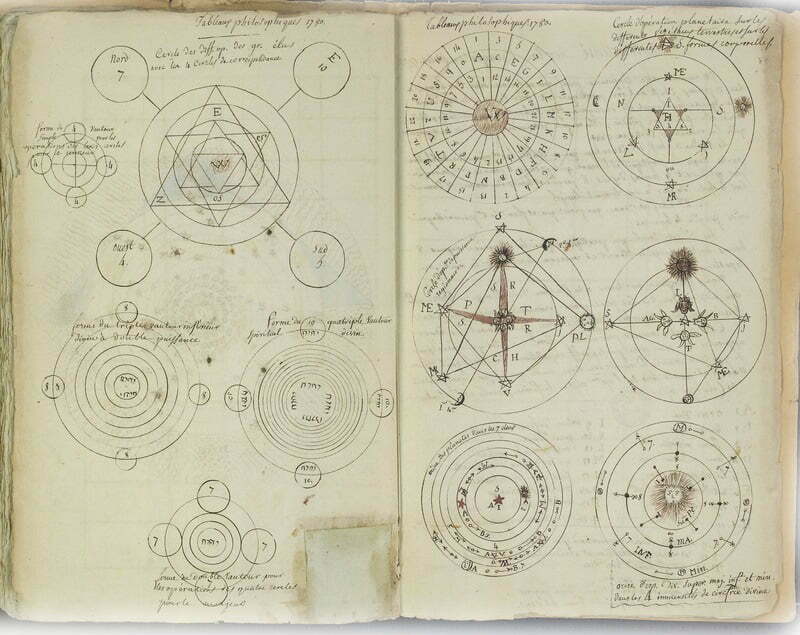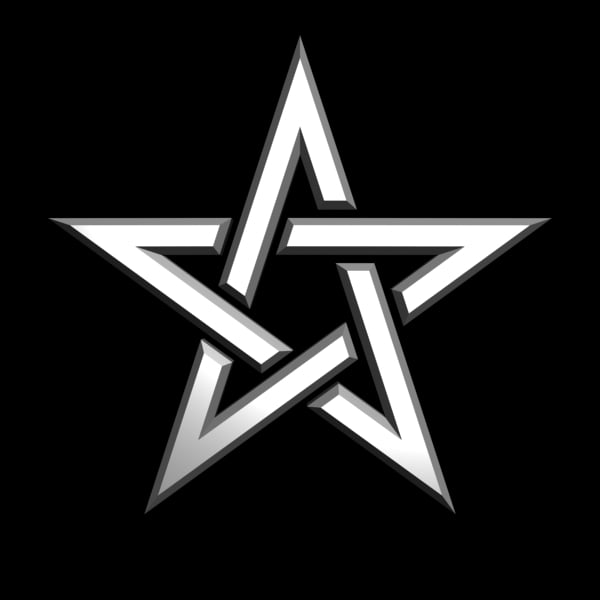Magic Circles

Having chosen a place for preparing and constructing the Circle, and all things necessary being prepared for the perfection of the Operations, take thou the Sickle or Scimitar of Art and stick it into the centre of the place where the Circle is to be made; then take a cord of nine feet in length, fasten one end thereof unto the Sickle and with the other end trace out the circumference of the Circle, which may be marked either with the Sword or with the Knife with the Black hilt.
Then within the Circle mark out four regions, namely, towards the East, West, South, and North, wherein place Symbols; and beyond the limits of this Circle describe with the Consecrated Knife or Sword another Circle, but leaving an open space therein towards the North whereby thou mayest enter and depart beyond the Circle of Art.
Beyond this again thou shalt describe another Circle at a foot distance with the aforesaid Instrument, yet ever leaving therein an open space for entrance and egress corresponding to the open space already left in the other.
Beyond this again make another Circle at another foot distance, and beyond these two Circles, which are beyond the Circle of Art yet upon the same Centre, thou shalt describe Pentagrams with the Symbols and Names of the Creator therein so that they may surround the Circle already described.
Without these Circles shalt thou circumscribe a Square, and beyond that another Square, so that the Angles of the former may touch the centres of the sides of the latter, and that the Angles of the latter may stretch towards the four quarters of the Universe, East, West, North, and South; and at the four Angles of each square, and touching them, thou shalt describe lesser Circles wherein let there be placed standing censers with lighted charcoal and sweet odours.
Chapter IX, The Key of Solomon the King (Clavicula Salomonis)
Liber Mysterium, The Netbook of Witches and Warlocks
By Timothy S. Brannan and The Netbook of Witches and Warlocks Team
Magic Circles are used for focusing magic, summoning creatures and protection. Like the magical correspondences, the appropriate circle is needed under different occasions. Often the witch uses a magical circle during rituals, sabbats or other ceremonies. They can be used to focus spellcasting and they are essential when summoning spirits, fiends or divine aid.
Most circles will be drawn on the ground with chalk, charcoal or some other powdery substance. Circles are drawn clockwise for white magic and counterclockwise for black or evil magic. The exact nature of the spell or ritual may require other, rarer materials. Often the circle is drawn with other symbols of power, including the witch’s own personal symbol. The materials that make up the circle will also be of significance to the function it is being used. For maximum effect the witch will use oils, powders and spices from the lists above.
To construct a circle the witch needs to know what she is going to do (summoning a demon, conversing with her Goddess, etc.), what materials will be appropriate and what symbols she needs to use. All of this can take hours to days to prepare and months or years to research. Generally speaking, the simpler the function of the circle, the easier it will be to construct and the cheaper the cost. Simple things like monthly rituals and communing with her Goddess should be relatively easy for the witch. These will be found in the coven’s Book of Law. Adventures can be built around solitaries and witches looking for other types of rituals and the materials needed.
The lines on a magic circle are normally double lines spaced far enough apart for the witch to inscribe symbols and runes within. Most importantly, great care needs to be taken by the witch when drawing such symbols. Incorrect symbols are useless.
To make magic circles the witch requires the Cast Magic Circle feat.
Witch’s arcane spell castings are prepared via a series of rituals. Each spell holds a different ritual, but there are some things that do not change. Whenever a witch begins preparing a spell, she usually creates a magic circle around her. The type of Magic Circle varies with the type of spell being prepared. Simply drawing in the dirt, sand, or spreading salt or another substance around the witch typically creates magic circles. Simple magic circles of these sort require the witch to make a Craft (Magic Circle), Spellcraft or Knowledge (Witchcraft) check, DC of 10. A failed check means the circle is incorrect or inaccurate in some manner, but the witch will still believe that it is correct.
More experienced witches (those with the Create Magic Circle feat) will sometimes create larger Magic Circles to aid them. Creating an enchanted magic circle takes 1 minute per foot radius. Unless otherwise noted, an Enchanted Magic Circle affects only the witch who created it. A magic circle can be created by any means, ranging from an extensive tile design created into the floor or to drawing in the dirt with a stick, but if the magic circle is ever disturbed even the slightest bit, the powers granted by the Magic Circle cease working.
Thaumaturgic Circle: This Magic Circle is used when preparing a spell of the universal school of magic. A Witch who created a Thaumaturgic Circle with the Create Magic Circle feat gains a +1 bonus to successes for spells cast within the circle, for a number of times per day equal to the witch’s Wisdom modifier. The magic circle is used for spell focusing. Often used by the witch during her rituals and sabbats. This is used when casting any spell.
Triangle: The Single Triangle is used when preparing spells related to change, including most evocation or transmutation spells. A Witch standing within a Triangular Magic Circle can cast one spell per Magic Circle at double the duration.

Also known as the Elemental Triangle or Thaumaturgic Triangle.
Pentagram: The most common is the pentagram, also known as a pentangle. This is a five-pointed star. Good or neutrally aligned witches will use it with the point of the star facing up or forward. Evil aligned witches use an inverted pentagram. Often witches will adopt the pentagram as part of their own personal symbols.
The Star Shaped pentagram is used when preparing healing and other beneficial spells. Witches with the Circle Casting Feat standing within a Pentagram treats all healing and protective abjuration spells as if they were cast at 2 levels higher than the witch’s caster level.
Inverted Pentagram: The Inverted Pentagram is used when preparing damaging and other harmful spells. A Witch standing within a Pentagram treats all harming spells as if they were cast at 2 levels higher than the witch’s caster level.
An image in the 1897 book “La Clef de la Magie Noire” by Stanislas de Guaita (reproduced on the front page of “A Pictorial History of Magic and the Supernatural” by Maurice Bessy).
Hexagram: Two triangles are placed in a circle to create a six-pointed star. The upright triangle represents the male energies of the universe. The inverted triangle represents the feminine energies. The Hexagram is used when preparing Abjuration spells. A witch standing within a Hexagram grants damage reduction equal to her Wisdom modifier to all allies (including herself) standing within the Hexagram.
Octogram: Two squares are placed within a circle to form an eight-pointed star. The Octogram is used when preparing spells that could be diametrically opposed.
This includes elemental spells (fire, earth, water, air) and alignment based (good, evil, lawful, chaotic).
Outsiders related to a single aspect (fire, earth, water, air, good, evil, lawful, or chaotic) may not enter the magic circle or target anyone within the circle. If the Witch conjured the outsider herself, they may not leave the Magic Circle or target anyone outside of the circle. The type of outsider is chosen at the time the Magic Circle is created.
Decorative motif in San Pancrazio, Florence.
Combined Circles
The witch may try combining the various circles for additional benefits. One such example would be a Cabalist Magic Circle, a combination of the Triangle and the Pentagram.

 Buy me a coffee
Buy me a coffee